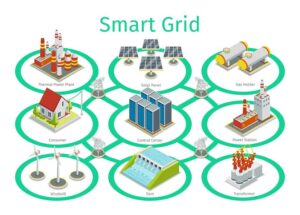Connecting the Dots: Smart Grids and the Future of Renewable Energy

Incorporating renewable energy sources is a paramount objective in pursuing a sustainable and environmentally friendly energy future. However, the inherent intermittency of renewables poses a unique set of challenges for conventional power grids. This is where the transformative potential of Smart Grids comes into play – an intelligent, adaptive, and interconnected solution poised to serve as the nerve center of a renewable energy future. This article delves into the pivotal role played by Smart Grids in revolutionizing our energy infrastructure and facilitating the transition towards a cleaner, more efficient grid.
The advent of renewable energy sources, such as solar and wind, introduces variability and intermittency to the grid. Traditional grids grapple with real-time supply and demand imbalances, leading to inefficiencies and instability.
Many power grids worldwide confront the challenges of aging infrastructure, ill-equipped to navigate the complexities of a modern, decentralized energy landscape. It becomes imperative to upgrade and modernize infrastructure to integrate renewable energy sources seamlessly.
Smart Grids leverage cutting-edge sensors, communication, and control technologies to monitor and manage the real-time energy flow. Artificial intelligence algorithms scrutinize data, predict demand, identify potential faults, and optimize energy distribution.
Enabling the integration of Distributed Energy Resources (DERs), Smart Grids facilitate decentralized power generation and storage. This decentralization enhances grid resilience and diminishes the risk of widespread outages.
Empowering consumers to engage actively in energy management through demand response programs, Smart Grids foster real-time communication. This dynamic allows consumers to adjust energy usage based on grid conditions, contributing significantly to energy efficiency.
Equipped with self-healing capabilities, Smart Grids swiftly detect and isolate faults, minimizing downtime and disruptions. This resilience proves critical in adapting to unforeseen challenges such as extreme weather events and cyber threats.
Artificial intelligence algorithms analyze historical and real-time data, predicting energy demand patterns. This predictive capability enhances grid planning and resource allocation.
Deploying machine learning algorithms, Smart Grids optimize grid operations, enhancing the efficiency of energy distribution and mitigating wastage.
Artificial intelligence is pivotal in securing Smart Grids by continuously monitoring for cybersecurity threats and detecting anomalies indicative of malicious activities.
Smart Grids essentially epitomize a paradigm shift in our energy generation, distribution, and consumption approach. By seamlessly integrating artificial intelligence, these intelligent grids provide a scalable and adaptable solution to the intricate challenges of renewable energy integration. As the veritable nervous system of a renewable energy future, Smart Grids chart a course toward a more resilient, efficient, and sustainable energy infrastructure. Embracing this technological evolution is not merely a choice but a compelling necessity on our journey toward a greener and more harmonious tomorrow.